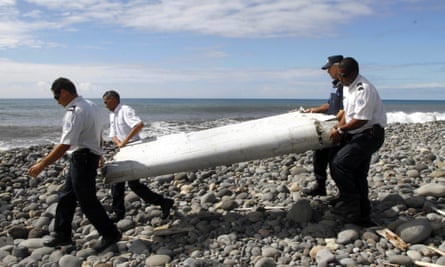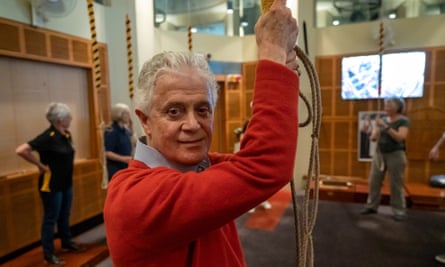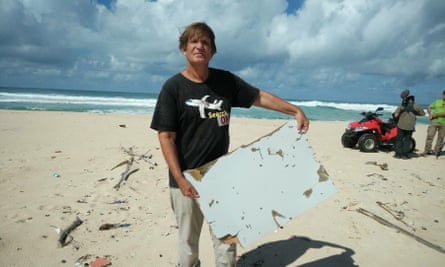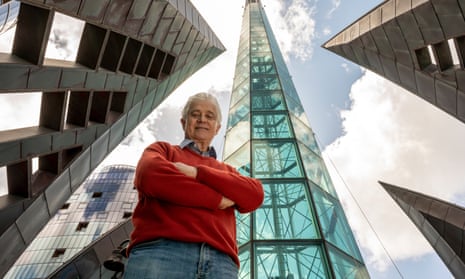Somewhere in the vast expanse of Earth’s oceans lies MH370, the Malaysia Airlines flight that disappeared on 8 March 2014 with 239 people on board.
Authorities closed the books on the search in 2017, but all over the world people are continuing the hunt. And one day the plane will be found.
So says the Australian who was in charge of the amateur search, because people won’t give up looking for it.
Peter Foley was the program director for the international effort led by the Australian Transport Safety Bureau. Hundreds of people helped search more than 120,000 square kilometres of the southern Indian Ocean seafloor. They mapped the area, tried to trace debris back to its origin, and prepared for a recovery mission, before the search was suspended at the start of 2017.
In its closing report, the ATSB explained its scientific processes and professed very human emotions while talking directly to the families of the disappeared.

“We share your profound and prolonged grief, and deeply regret that we have not been able to locate the aircraft, nor those 239 souls on board that remain missing,” the report says.
“It is almost inconceivable and certainly societally unacceptable in the modern aviation era … for a large commercial aircraft to be missing and for the world not to know with certainty what became of the aircraft and those on board.”
Foley focuses on that empathy and regret, and says MH370 will be found, and it will be found near the area they were looking in.
“It’s one of those things that will enthral people until the mystery is solved,” he says. “It is a mystery that must be solved and will be solved eventually.”
MH370 disappeared from air traffic control radar 38 minutes into its flight from Kuala Lumpur, Malaysia, to Beijing, China. Analysis of satellite and radar data showed it had kept flying for another seven hours.

Conspiracy theories about what happened abound. On social media people speculate about the involvement of organ harvesters and black holes, aliens and North Korea. Other theories, including that it was a murder/suicide plot by the pilot, or that the pilot was unconscious, have been taken more seriously – although never confirmed.
In January 2018 the Malaysian government contracted marine robotics company Ocean Infinity to send in autonomous underwater vehicles in a “no-find, no-fee” deal. By May they had given up – for now.
There are still dedicated searchers, ranging from conspiracy theorists to well-intentioned amateurs and full-blown experts.
They include those who work with new data models and are driven to solve the MH370 mystery for glory, or money, or knowledge, or to give the loved ones left behind some answers.
Dr Ian MacLeod, an expert in shipwrecks, a diver of the deep, and a lover of ocean mysteries, also says it’s a matter of when, not if, it will be found.

A world-famous authority on maritime corrosion and conservation and a WA Museum fellow, Macleod says MH370 mystery hunters are people who enjoy “unscrambling the bullshit” around what happened to that plane.
“What happens is there are people who do not accept lies, and sniff them out at a thousand paces and who are passionate and persistent and clever,” he says. “You need those three combinations, just like you need three points of reference to triangulate a falling meteorite.
“People will not give up until the last breath has gone out of their body. People will find it. New information will come to light, governments will change, and they’ll go back and find it.”
The Malaysian government said in 2018 that it wasn’t ruling out future missions, and the family members of those lost are urging them on. Ocean Infinity has said it is open to a new search.
One of those leading the pack of MH370 detectives is aerospace engineer Richard Godfrey, part of the independent group of scientists hunting for the wreckage.
Speaking from Frankfurt in Germany, Godfrey says he’s “quite focused”, spending hours every day for the past seven-and-a-half years on the search. He uses the weak signal propagation report (WSPR) network to track disturbances in radio waves. A global database of radio waves that are reflected or scattered when an aircraft crosses them.
Imagine trip wires forming a mesh across a prairie, he says.
“Each step you make you tread on particular trip wires and we can locate you … we can track your path as you move through the prairie.”
Those disturbances, mapped together with satellites pinging the plane, can help “fill in some of the gaps and help us to know more precisely where MH370 crashed”. He says his findings suggest the MH370 pilot laid false trails to confuse authorities before plunging into the southern Indian Ocean. That in turn suggests the pilot knew what he was doing.

Godfrey says his interest in the fate of MH370 stemmed from something that happened to him. In 2009 he was booked on a flight from Rio de Janeiro to Paris. A week later that same flight, Air France 447, crashed into the Atlantic with 228 people on board. After nearly two years of searching, the main wreckage was found.
When MH370 went missing, Godfrey wanted answers. So do the next-of-kin, he says, and the aviation industry, not to mention anyone who gets on a plane expecting to land safely at the other end.
There are many others who share his passion. Wreck hunter Blaine Gibson is still searching for answers. Bob Ballard, who found the Titanic wreck in 1985, wants to help. The families have always said they would keep fighting.
MacLeod, the Perth-based corrosion expert, talks about what remains and how knowing what’s down there could help those left behind.
Depending on the damage done on impact, if the plane settled on a hard surface – say, rock at the bottom of a watery abyss – it could be well preserved. But if it has sunk into silt, the aluminium will have corroded. Much will depend on where it is, and deep sea currents that can have high or low salinity, high or low temperatures.
But it could look “remarkably unchanged”, MacLeod says, with the windows popped out by the pressure, but the tube intact. And it should be left under water, because bringing into the air could see it crumble.
The important thing is giving the families closure. MacLeod talks about the emotion of finding the HMAS Sydney, when survivors and relatives went out and laid wreaths over the site.
And he was on the HMAS Anzac for the 100th anniversary of the sinking of AE2 – Australia’s second submarine – where joint Australian/Turkish bands played in the memory of those who went down. (Australia’s first submarine, the AE1, was found in 2017 off the coast of Papua New Guinea).
MacLeod thinks a lot about ocean mysteries and the importance of the rituals of grief.

As a boy in Ballarat, he rang the memorial bells to mark Harold Holt’s death on a summer’s day in 1967when the then prime minister went missing in the heavy surf near Portsea in Victoria. He was never seen again. MacLeod rang the bells, and went on to a career based on lives lost at sea.
“There are certain rites of passage that you participate in,” he says. “I owe my whole professional career in corrosion and conservation to the death and misfortune of people who got shipwrecked on the WA coast.
“People who lost their lives, that was not in vain, because their story lives on … that’s what motivates me. It’s why I give public talks about decay and preservation … even after we’re dead, our stories only begin to be retold in another way, through the processes of decay.
“Every bit of decay has a story to tell.”
Foley is retired now, but is obviously still emotionally connected to the MH370 story, and he has a clear-eyed overview of everything that’s happened since the ATSB search ended.
He says he is “extraordinarily keen” to see another search started, for the plane to be found. He is also extraordinarily keen to direct questions about his role back to the work other people did, and the reason they did it – the families.
“I honest believe the people who were so far from home in really appalling weather in the Indian Ocean are the absolute heroes of the search and we really worked incredibly hard to find that aircraft,” he says.
“And it would be such a relief for everyone involved to see it was finally found and that there were answers for 239 families.
“Whether it’s pure dumb luck and a fisherman picks up a piece of debris on a long line or whether it’s an advance in technology that allows us to search in great detail large areas of the ocean floor or whether it’s a philanthropist who uses existing technology … it will be found.”
